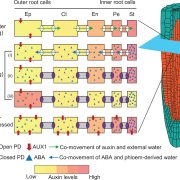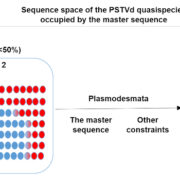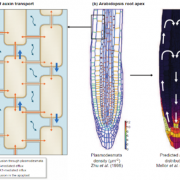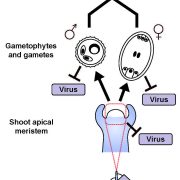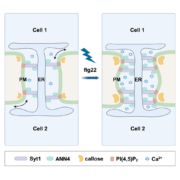A New Look at Virus Movement: An Unexpected Role of dsRNA-Induced Immunity
Huang et al. investigate the mechanisms of dsRNA-induced pattern-triggered immunity against viruses.
https://doi.org/10.1093/plcell/koad176
Manfred Heinlein (Institut de biologie moléculaire des plantes, CNRS, Université de Strasbourg, 67000 Strasbourg, France)
Background: Plants use different defense mechanisms against pathogens. The major mechanism that plants use for defense against viruses is known as RNA silencing. This mechanism is triggered by the presence of viral double-stranded (ds)RNA and uses small RNAs to inhibit viral replication by targeting the viral genome for degradation. Recently, it was found that dsRNA elicits antiviral defense also through a protein-mediated mechanism known as pattern-triggered immunity (PTI). However, the underlying mechanism of antiviral PTI and how viruses overcome this plant defense mechanism to cause infection is unknown.
Question: In this study we asked how dsRNA-induced PTI acts to inhibit virus infection and whether we can identify components of the PTI signaling pathway. Moreover, we wanted to know how viruses overcome this plant host defense response in order to cause infection.
Findings: We demonstrate that dsRNA-induced PTI targets plasmodesmata (PD), the intercellular communication conduits in plant cell walls that viruses use to spread infection from cell to cell. By inducing the deposition of callose, dsRNA-induced PTI reduces PD permeability, thus restricting virus movement. We identified PTI signaling components required for dsRNA-induced PD callose deposition and delineate a PTI pathway showing important difference to PTI pathways triggered by microbial elicitors. Moreover, viral movement proteins (MPs) suppress the dsRNA-induced callose deposition response at PD. This leads to a model of how plant immune signaling constrains virus movement and how viruses counteract this layer of immunity.
 Next steps: This study calls upon the identification of the PTI dsRNA receptor and the mechanisms of PTI signaling (involving identified components such as SERK1, BIK1, calcium channels, CML41, PDLP1/2/3) and PTI suppression by MPs, and how dsRNA-induced PTI and RNA silencing are controlled during the spread of infection.
Next steps: This study calls upon the identification of the PTI dsRNA receptor and the mechanisms of PTI signaling (involving identified components such as SERK1, BIK1, calcium channels, CML41, PDLP1/2/3) and PTI suppression by MPs, and how dsRNA-induced PTI and RNA silencing are controlled during the spread of infection.
Reference:
Caiping Huang, Ana Rocio Sede, Laura Elvira-González, Yan Yan, Miguel Rodriguez, Jerome Mutterer, Emmanuel Boutant, Libo Shan, and Manfred Heinlein.. (2023). dsRNA-Induced Immunity Targets Plasmodesmata and is Suppressed by Viral Movement Proteins https://doi.org/10.1093/plcell/koad176


